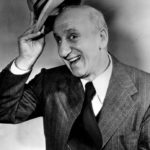 Few performers have had as much success in as many media as Jimmy Durante, whose 50-year career spanned from vaudeville to TV. Born in New York’s Lower East Side on Feb. 10, 1893, Durante began working at age 6 in his father’s barbershop and left school after the eighth grade to help support his family full-time. By 17, he was accompanying singing waiters at a Coney Island saloon. Five years later, he was leading a five-piece band in a Harlem cabaret, where he met collaborator Eddie Jackson.
Few performers have had as much success in as many media as Jimmy Durante, whose 50-year career spanned from vaudeville to TV. Born in New York’s Lower East Side on Feb. 10, 1893, Durante began working at age 6 in his father’s barbershop and left school after the eighth grade to help support his family full-time. By 17, he was accompanying singing waiters at a Coney Island saloon. Five years later, he was leading a five-piece band in a Harlem cabaret, where he met collaborator Eddie Jackson.
Durante made his first recording in 1918, playing piano with the Original New Orleans Jazz Band, and in 1923, he and Jackson opened Club Durant, where they met Lou Clayton. The three men developed a comedy act and, by 1927, were headlining the vaudeville bill at New York’s Palace Theatre. Two years later, the team made their Broadway debut in George & Ira Gershwin’s Show Girl for Florenz Ziegfeld (with Durante as Snozzle) and made their film debut in Roadhouse Nights, which you can watch below.
After the trio returned to Broadway in Cole Porter’s The New Yorkers (1930), Durante received a solo film contract, so Clayton and Jackson became his managers. MGM featured Durante in dozens of movies, but they couldn’t find an appropriate vehicle for him, so he was back on Broadway in the 1933 Henderson-Brown revue Strike Me Pink. Two years later, Durante had his biggest stage success with Rodgers & Hart’s Jumbo for Billy Rose. His next musical was Cole Porter’s Red, Hot and Blue. Below is a silent home movie of the original 1936 production of that musical with Durante, Bob Hope, and Ethel Merman.
The early 1940s were a professional and personal low for Durante, who saw the deaths of his father, sister, and wife Jeanne in rapid succession. Then in 1943, he was teamed with Garry Moore to fill a vacated NBC radio slot, which revived his career. To honor his wife, Durante signed off each broadcast with “Good night, Mrs. Calabash, wherever you are.” With the show’s success, Durante was back at MGM in films such as Two Girls and a Sailor (1944). Below is Durante singing his signature song, “Inka Dinka Doo,” under the baton of Harry James, in that film.
His subsequent MGM musicals include the Oscar-nominated Music for Millions (1944), Two Sisters from Boston (1946), It Happened in Brooklyn with Frank Sinatra (1947), and the Esther Williams vehicles This Time for Keeps (1947) and On an Island with You (1948). Below his Durante singing his Top 40 chart hit “Umbriago” in Music for Millions.
In 1950, Durante made his TV debut as co-host of Four Star Revue, which evolved into All Star Revue, then The Colgate Comedy Hour, receiving a 1952 Emmy nomination and a 1953 Emmy award as best comedian. From 1954 to 1956, he hosted his own half-hour TV variety show, and he ended the decade with two stars (one for film, one for radio) on the Hollywood Walk of Fame. He began the 1960s with the film adaptation of Jumbo (1962), for which he received a Golden Globe nomination. Below is Durante with Stephen Boyd, Doris Day, and Martha Raye in “Sawdust and Spangles and Dreams” in that film.
He spent the rest of the 1960s recording a series of albums, including September Song (1963), whose “Young at Heart” was featured in the 1991 film City Slickers, and Jimmy Durante’s Way of Life (1964), whose “As Time Goes By” and “Make Someone Happy” are featured in the 1993 film Sleepless in Seattle. He also starred in two TV specials: the 1966 Alice Through the Looking Glass as Humpty Dumpty and the 1969 Frosty the Snowman as Narrator, which you can watch below. After a series of strokes, he died Jan. 29, 1980. In his eulogy, Bob Hope noted, “Success can be measured by the friends one has. And believe me, Jimmy Durante was the most successful man I know.”
